Living in duck and grebe central, I have a lot of opportunities to photograph birds in water, and when a new species arrives each spring, it’s always exciting, and worthy of trying to photograph it. So when the first Horned Grebes surprised me 2 miles south of my office the sunny Sunday morning 10 days ago, I drove by a single grebe, then a pair, which necessitated turning around to get into position for a possible photo. As I approached the pair, it appeared to be a definite ‘no go’ right from the start. One, then the other dived and didn’t surface until they were far beyond my photo range; so I slowly ambled on to the lone Horned Grebe.

This colorful waterbird was positioned at the far edge of my photo range, but I decided to give it a go and see if the grebe might swim a little closer to the eastern shore; after all, it seemed more curious than concerned at the appearance of my white car under the morning sun. Even from a distance, it was clear the Horned Grebe would be a good photo subject as I focused on some of the colors and plumage features of this small diving bird.
Small or not, this grebe had real character, with mesmerizing bright red eyes positioned at the lower end of golden plumes that extended to the back of its head, all set off by a black feathered hood that the grebe could expand or diminish above its rufous neck and breast. The Horned Grebe held my attention as an impressive bird and a fitting photo subject!
Strong wind created waves on the surface of the lake, but the grebe wasn’t fazed as it dived again and again for food, occasionally surfacing with a small fish, but more often a large caddisfly larvae. As it dived, it surfaced closer and closer to my position, providing as many photo ops as I was willing to stay for. The grebe was dynamically attractive as it turned at different angles, expanded its hood feathers and horn plumes with its red eyes flashing, then folded its headdress sleek against its head a moment before diving again.

The Eyes Have It
As it turned from side to side, it provided more and more photo ops, but it soon became clear that when the small grebe looked directly at me, face to face, its 2 beaming red eyes evoked a bit of a demonic look. After that, it was hard to look at it from any angle without keying in on those eyes, although that’s a good thing: You always want to focus on birds’ eyes when you are photographing, so the bright red eyes created a definite focal point with the Horned Grebe.
As the grebe dived it would work its way right or left, which made me want to reposition to try to stay at the best angle to utilize the morning sunlight, use the best photo angles, and to stay close enough to get sharp images of the active bird. When I wanted to reposition, I waited for the grebe to dive below the water surface before starting my car’s engine. Then, double-checking to be sure the grebe was still underwater, I would drive 10 or 15 feet forward or backward to hopefully be in better position for photos when the grebe surfaced.

This, of course, is a classic reason why I like to use my vehicle as a “mobile blind.” Sure, I could walk along the shore of the lake, but would the grebe be as trusting? I highly doubt it. Birds and other wildlife usually are more trusting of a vehicle than of a person – except where they get familiar with people passing by regularly, like in a wildlife area that has hiking paths adjacent to habitat used by the birds.
Of course, the best part of using a vehicle as a mobile blind is that you can make small movements, but you can also make big moves; like when you are ready to search for the next photo subject, which might be a few miles down the road. My vehicle also provides a place for me to steady my camera lens, by resting the lens on the bottom, side, or top of the open window frame. These 2 aspects of using my “mobile blind” were withdrawn later that day when I needed to hike a semi-circle through a prairie area and stand holding my camera to photograph Hudsonian Godwits. Standing in the open, the rare godwits were immediately aware of me and I couldn’t get as close as I would have liked; plus, I was nowhere near as steady when trying to hand-hold my camera and lens rather than steadying it on my car’s window frame.

OK, back to my Horned Grebe photo episode: Another thing about photographing from my vehicle is that I was protected from the cool wind whipping off the lake surface. Although I turned the ignition off to stop engine vibrations, if I was uncomfortable due to the weather I could always start it again to run the heater for a minute, or even use the air conditioning when warranted. That morning, wearing a light jacket was adequate with just the one window open. Later in the season, when mosquitos become a factor, a vehicle can be helpful in that you can close the window and you’re protected until the appearance of next bird that entices you to open the window to photograph.
Throughout this photo session I used an f-10 aperture to get a fairly broad area in focus, and with my camera dialed to the Av (aperture priority) setting, the camera set the corresponding shutter speed, which was ample considering the grebe wasn’t very active when it was on the surface. The sharpness of the resulting photos was quite impressive, and the colors were 100 percent accurate with perfect morning sunlight at my back.

Spending time with this first of season Horned Grebe was a delight, as everything came together so simply and effortlessly, and the small grebe provided big dividends in the form of primo photos. It was yet another example of a bird being a “species ambassador” – a trusting bird that allows you to spend time in its company while providing a variety of photo opportunities. I always want to thank the ambassadors and wish them well as I drive away – and sometimes I do. That particular SunDay, I was especially lucky at finding many species ambassadors, which made it an especially rewarding day on a number of levels.
Some days, being a birder is especially fulfilling, and I’m convinced that getting photographs of some of the birds we encounter makes our outdoor experiences all the more enjoyable. And it reinforces my belief that birds are the ultimate expressions of nature. Hoping you are having some especially rewarding and memorable birding experiences, I wish you “Good Luck,” because finding birds, appreciating them, and especially photographing birds requires a degree of good luck. Enjoy this ever-improving spring birding season!
Article and photographs by Paul Konrad
Share your bird photos and birding experiences at editorstbw2@gmail.com